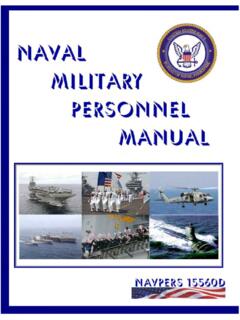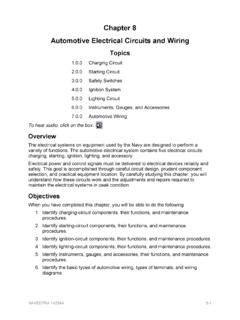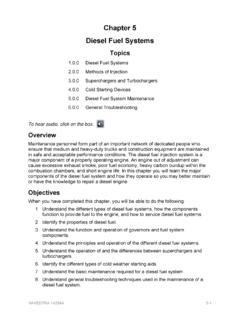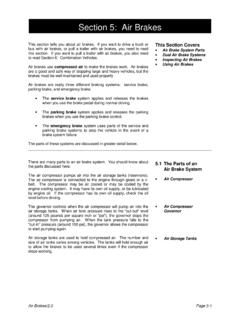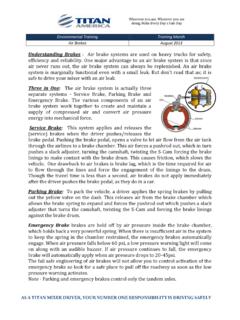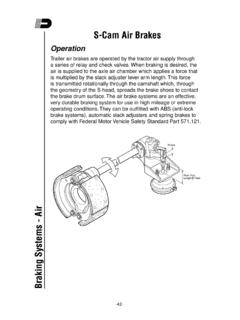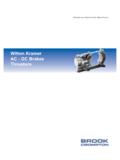Transcription of Chapter 13 Brakes - Seabee Online
1 Chapter 13 Brakes Topics Hydraulic brake System Air brake System To hear audio, click on the box. Overview The brake system is the most important system on a vehicle from a safety standpoint. You, as the mechanic, are trusted to do every service and repair operation correctly. When working on a brake system, always keep in mind that a brake system failure could result in a fatal vehicle accident. It is up to you to make sure the vehicle brake system is in perfect operating condition before the vehicle leaves the shop. In this Chapter we will discuss the operational characteristics and components of the hydraulic and air brake systems that are common to vehicles used in the Naval Construction Force (NCF).
2 Objectives When you have completed this Chapter , you will be able to do the following: 1. Understand the hydraulic and mechanical principles of a brake system. 2. Identify the major components of hydraulic, air, and air-over -hydraulic brake systems. 3. Understand the operation of hydraulic and air brake systems. 4. Understand the operation of an antilock braking system. 5. Understand the operation, terms, and component functions of a hydraulic brake system. 6. Understand the procedures for servicing a hydraulic brake system. 7. Understand the operation, terms, and component functions of an air brake system.
3 8. Understand the procedures for servicing an air brake system. NAVEDTRA 14264A13-1 Prerequisites This course map shows all of the chapters in Construction Mechanic Basic. The suggested training order begins at the bottom and proceeds up. Skill levels increase as you advance on the course map. Automotive Chassis and Body C Brakes M Construction Equipment Power Trains Drive Lines, Differentials, Drive Axles, and Power Train Accessories Automotive Clutches, Transmissions, and Transaxles Hydraulic and Pneumatic Systems Automotive Electrical Circuits and Wiring B A Basic Automotive Electricity S Cooling and Lubrication Systems I Diesel Fuel Systems C Gasoline Fuel Systems Construction of an Internal Combustion Engine Principles of an Internal Combustion Engine Technical Administration Features of this Manual This manual has several features which make it easy to use Online .
4 Figure and table numbers in the text are italicized. The figure or table is either next to or below the text that refers to it. The first time a glossary term appears in the text, it is bold and italicized. When your cursor crosses over that word or phrase, a popup box displays with the appropriate definition. Audio and video clips are included in the text, with italicized instructions telling you where to click to activate it. Review questions that apply to a section are listed under the Test Your Knowledge banner at the end of the section. Select the answer you choose.
5 If the answer is correct, you will be taken to the next section heading. If the answer is NAVEDTRA 14264A13-2incorrect, you will be taken to the area in the Chapter where the information is for review. When you have completed your review, select anywhere in that area to return to the review question. Try to answer the question again. Review questions are included at the end of this Chapter . Select the answer you choose. If the answer is correct, you will be taken to the next question. If the answer is incorrect, you will be taken to the area in the Chapter where the information is for review.
6 When you have completed your review, select anywhere in that area to return to the review question. Try to answer the question again. NAVEDTRA HYDRUALIC brake SYSTEM In hydraulic braking systems, the pressure applied at the brake pedal is transmitted to the brake mechanism by a liquid. There are two common types of hydraulic brake systems used on modern vehicles: drum and disc Brakes . Principles of Braking It is known that to increase the speed of a vehicle requires an increase in the power output of the engine. It is also true, although not so apparent, that an increase in speed requires an increase in the braking action to bring a vehicle to a stop.
7 A moving vehicle, just as any other moving body, has what is known as kinetic energy. Kinetic energy is the energy an object possesses due to its relative motion. This kinetic energy, which increases with speed, must be overcome by braking action. If the speed of the vehicle is doubled, its kinetic energy is increased fourfold; therefore, four times as much energy must be overcome by the braking action. Brakes must not only be capable of stopping a vehicle but must stop in as short a distance as possible. Because Brakes are expected to decelerate a vehicle at a faster rate than the engine can accelerate, they must be able to control a greater power than that developed by the engine.
8 This is the reason that well designed, powerful Brakes have to be used to control the modern high-speed vehicle. It is possible to accelerate an average vehicle with an 80-horsepower engine from a standing start to 80 mph in about 36 seconds. By applying the full force of the Brakes , such a vehicle can be decelerated from 80 mph to a full stop in about seconds. The time required to decelerate to a stop is one eighth of the time required to accelerate from a standing start. Therefore, the Brakes harness eight times the power developed by the engine. Thus about 640 (8 x 80) horsepower has to be spent by the friction surfaces of the Brakes of an average vehicle to bring it to a stop from 80 mph in seconds.
9 Vehicle Stopping Distance Operator reaction time is the time frame between the instant the operator decides that the Brakes should be applied and the moment the brake system is activated. During the time that the operator is thinking about applying the Brakes and moving his or her foot to do so, the vehicle will travel a certain distance depending on the speed of the vehicle. After the Brakes are applied, the vehicle will travel an additional distance before it is brought to a stop. Total stopping distance of a vehicle is the total of the distance covered during the operator s reaction time and the distance during which the Brakes are applied before the vehicle stops.
10 Figure 13-1 shows the total stopping distance required at various vehicle speeds, assuming that the average reaction time is 3/4 second and that good Brakes are applied under most favorable road conditions. Figure 13-1 Total vehicle stopping distance of an average vehicle. NAVEDTRA Braking Temperature Brakes are devices that convert the energy of a moving vehicle into heat whenever the Brakes are applied. This heat must be absorbed and dissipated by the brake parts. Unless the heat is carried away as fast as it is produced, brake part temperatures will rise.




